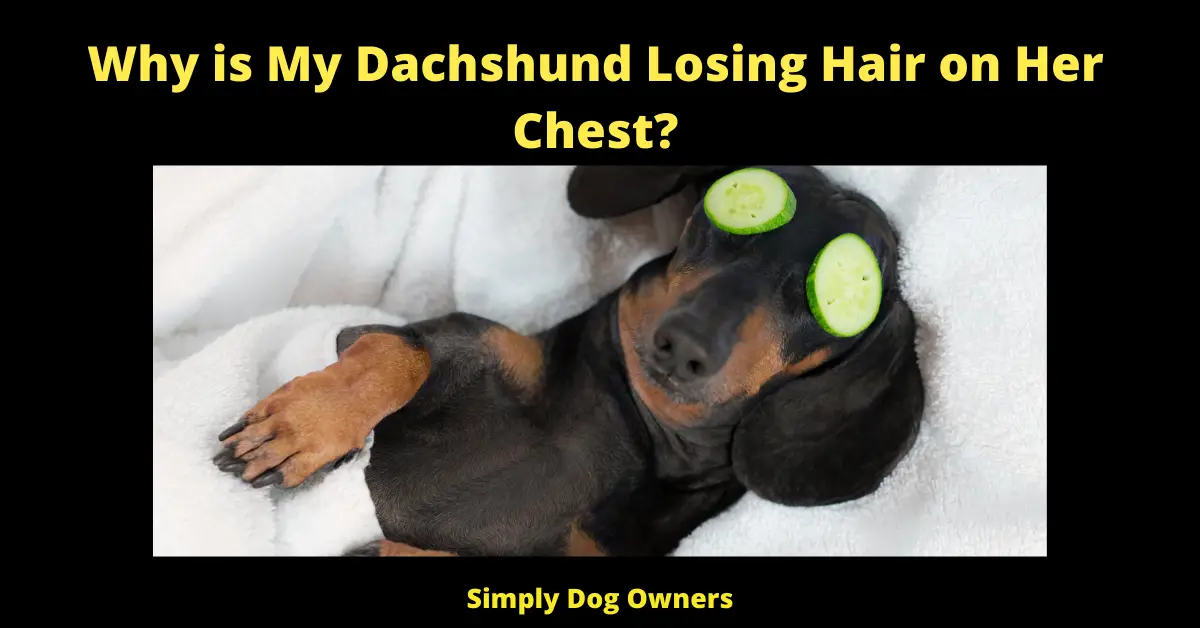- Pressure sores
- Friction (from a collar, for example)
- Nervous chewing or licking
- Trauma and scarring
- Chemotherapy
- Post-surgical clipping
- Infection
- (bacterial, yeast, or fungal)
- Ringworm (fungal infection)
- Sex hormone imbalance
- Cushing’s disease
- Allergies (fleas, food, environmental, contact)
- Mites (Mange)
- Abnormality in the growth of the hair shaft
- Thyroid disorder
- Skin cancer
- Genetics (certain breeds can develop hair loss in adulthood on ears, chest, thighs, or in certain pigmented parts of the body)
Why is My Dachshund Losing Hair on her Chest?
Why is my Dachshund losing hair on her chest? Alopecia, or hair loss, is common in Dachshunds. Self-trauma or a hair follicle disorder may cause this. Dachshunds have a thin coat and will shed large clumps of fur. Their skin would be scaly, swollen, and probably tainted. We may call this hair loss if they are losing a significant amount of hair that isn’t coming back. Hair loss is a significant problem that should not be neglected. When a dog’s skin is uncovered, he or she is more vulnerable to sunburn and cold. Their fur coats keep them warm and cover their skin.
Dachshund
Dachshund is a loyal companion and is good with children, but Dachshunds suffers from hair loss vertebral disc problems due to their long backs. So this dog is not an excellent choice for anyone who has many steps in the house.
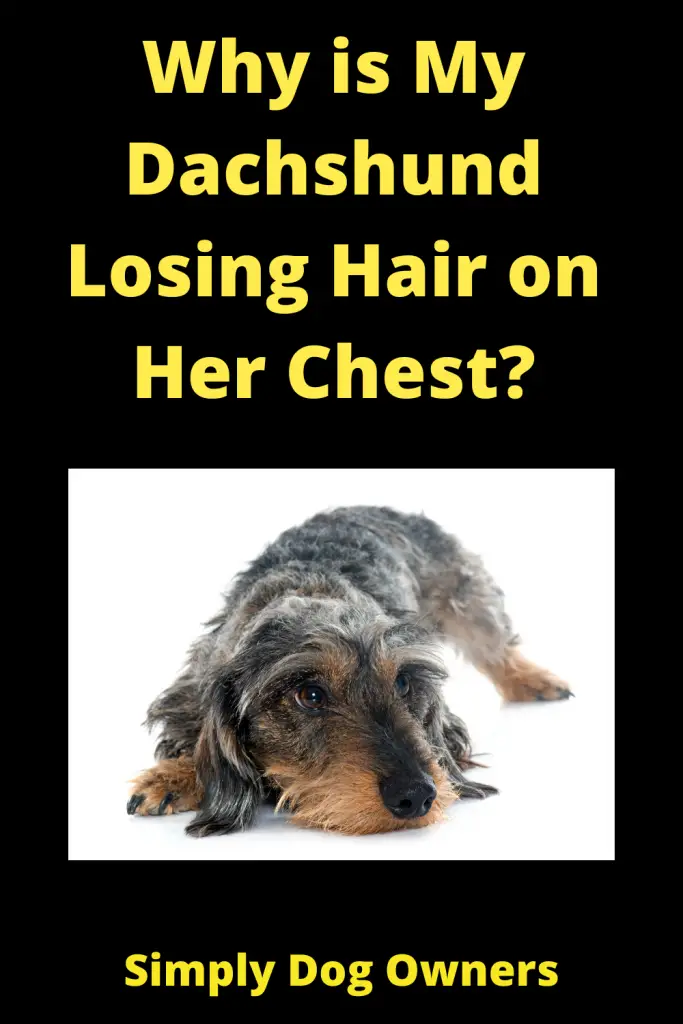
Breed Characteristics
Weight Range:
- Male: 9-32 lbs.
- Female: 9-32 lbs.
Height at Withers:
- Male: 13-14 inch
- Female: 12-13 inch
Other Body Features
- Back: Long back
- Face: Dolichocephalic (long face)
- Legs: Short bowed legs
- Ears: Floppy ears (naturally)
- Exercise Requirements: 20-40 minutes/day
- Energy Levels: Very energetic
- Longevity Ranges: 12-14 yrs.
- The tendency to Drool: Low
- The propensity to Snore: Low
- The propensity to Bark: High
- The tendency to Dig: High
- Social/Attention Needs: Moderate
Coat Characteristics
- Coat Length: Short/Long
- Coat type: Hard coat, Straight, Flat.
- Coat Colours: Black, chocolate, wild boar, grey or fawn with tan, brindle
- Overall Grooming Needs: Low
Club Recognitions
- AKC Classifications: Hound
- UKC Classifications: Scent Hounds
- Prevalence: Common
All three dachshunds, i.e., the smooth, wire, and long-coated, are found in two sizes called miniature and standard.
Miniatures are not classified separately by AKC but “compete in the class division of 11 pounds and under 12 months and older.” The standard size usually weighs between 16 and 32 pounds. There is no height standard for Dachshund, but the height is generally less than ten inches.
All three are known for their long backs and short, muscular legs, which gives them the title “sausage hound” or “hot dog.” They have long and floppy ears and a tail in line with the back.
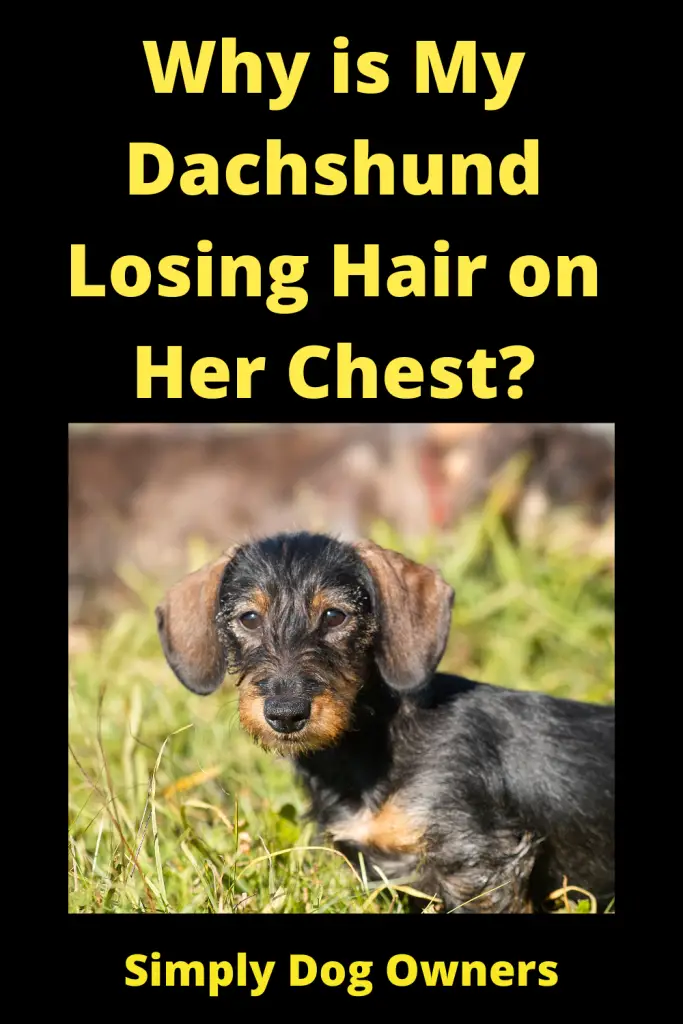
History
The Dachshund was bred in ancient Germany centuries ago to hunt beehives. “Dach” means badger, and “hund” means dog.
Dachshunds have tiny, muscular legs that enable the dog to hunt and crawl. Larger Dachshunds were used to chase deer or foxes. Miniature dachshunds were raised to hunt rabbits and ferrets.
The breed is still used for hunting, mainly in Europe, but in North America, the dog is usually a family pet. It is one of the most popular breeds of AKC.
Personality
Despite their size, Dachshund is known for his daring nature and will compete with animals much more significant than him. Some may be aggressive towards strangers and other dogs.
As a family dog, Dachshunds are loyal companions and good caregivers. If they are treated well, they are suitable for children. It can be a little challenging to train them.
Some Dachshund parents say that there are differences in personality in various races. For example, the long coat dachshund is reportedly quieter than the smoother coat type, and the wire coat Dachshund is more casual and clown-like.
Dachshunds were raised as predators, so it’s no surprise that many of them like to dig.
Living With
Dachshund suffers from disc problems because of their long back, so this dog is not a good choice for anyone who has many steps at home. To further protect Dachshund’s back, the dog should not be allowed to bounce on and off furniture, and his weight should be checked.
In addition to occasional grooming or brushing, a smooth coat requires extreme care. Long coat Dachshund requires daily brushing and combing. Wire coat dachshunds need grooming at least twice a year. The breed is considered the average shedder.
What are the Causes of Hair Loss?
Alopecia (or hair loss) in dogs is a fairly common issue caused by several conditions such as skin infections, allergies, and endocrine disorders. Hair loss can affect dogs of any age or breed. Since hair loss’s underlying cause can vary from mild to extreme, it’s essential to visit a veterinarian as soon as possible.
Pet owners most frequently asked questions such as Why is my Dachshund losing hair on its ears? Why is my Dachshund getting a bald belly? Why is my dog losing hair in patches and scabs? Why is my Dachshund Losing Hair on Her Tail? Why is my dog losing hair on her chest?
All of them have the same answer, i.e., many medical conditions such as alopecia, vitamin deficiency such as PICA, food allergies, and pests infestation are all the primary cause of losing your dog’s hair in different body parts
Food allergies in dogs can cause scratching, a rash along the belly, chest, and underarms, and eventually hair loss. Most dogs become allergic to food they’ve been consuming for a long time, and it’s not a new food. Your veterinarian will want to rule out alopecia. Masticatory Muscle Myositis, which causes head shrinkage or indentations, is an entirely different problem. You’ll want to double-check this as well.
How can I treat my Dog’s Hair Loss?
A variety of therapies for dog hair loss are available depending on the diagnosis.
Bacterial infections are treated with antibiotics (oral or topical).

Antifungal medications
Oral or topical antifungal medications can be used to treat ringworm and yeast infections.
Anabolic steroids
Some skin conditions can necessitate the use of this medication.
- Anti-cytokine or immunosuppressive drugs
- Controlling environmental allergies (Atopy) may be necessary. Care is always needed for the rest of one’s life.
- Immunotherapy is a type of immunotherapy that is used to treat
- For allergy desensitization, it may be necessary to take it orally or by injection.
- Psychiatric drugs
Nervous chewing or licking may be handled with this drug.
Shampoos with medicinal ingredients
Mange may be treated with creams or dips.
Hypoallergenic diets
Hair loss caused by food allergies is often resolved. Food allergies can take a long time to classify. The veterinarian will prescribe or suggest an over-the-counter hypoallergenic diet and explain how to transition to it properly.
Flea preventative once a month
can help with hair loss caused by flea allergies
Hormone therapy and thyroid medicine
Hair loss caused by hormonal and endocrine disorders may be reversed.
Supplements of vitamin E, vitamin A, and fish oil
It may be prescribed for pets with certain illnesses or a propensity for dry skin or skin infections.
An Elizabethian Cone
It might be necessary to use an electronic leash or a cone to keep your pet from scratching or itching the infected area until it heals.
Surgical procedures
They were maybe needed to remove skin cancer or tumor parts. Sex-hormone disorders can necessitate neutering or spaying your pet.
Chemotherapy-induced hair loss usually disappears once the treatment is over. When hair loss is caused by genetics, scarring, calluses, or pressure sores, it may be permanent. When properly handled, the majority of hair loss will go down. Recurrent skin conditions can necessitate long-term care.
What can Cause Bald Patches on Dogs?
Hair loss can cause bald patches on dogs. Some possible causes for dog hair loss or bald patches include:
What does Alopecia in dogs look like?
Hair loss is known as alopecia, and an overactive immune system causes it. Healthy cells, such as hair follicles, are attacked by the immune system.
Color Dilution and Pineal alopecia are two forms of alopecia that are especially common in dachshunds.
Color Dilution Alopecia is most common in weiner dogs that are blue or fawn-colored. Breeding out intense colors like brown or black to dilute the coat causes this form of alopecia. This condition may occur anywhere between six months and three years of age. Breeding out solid colors, such as brown or black, to dilute the coat causes this form of alopecia. This condition may occur anywhere between six months and three years of age. Dry, scaly skin and infected hair follicles are other symptoms.
The infection would need to be treated, but the disease cannot be stopped. Dogs with this illness are advised not to breed to prevent the disease from spreading.
Pineal Alopecia is a form of common pattern baldness distinguished by hair loss, which is behind the ears. It usually begins between the ages of six months and a year, and the pattern is the same on both ears. The ears may be hairless by the age of eight or nine.
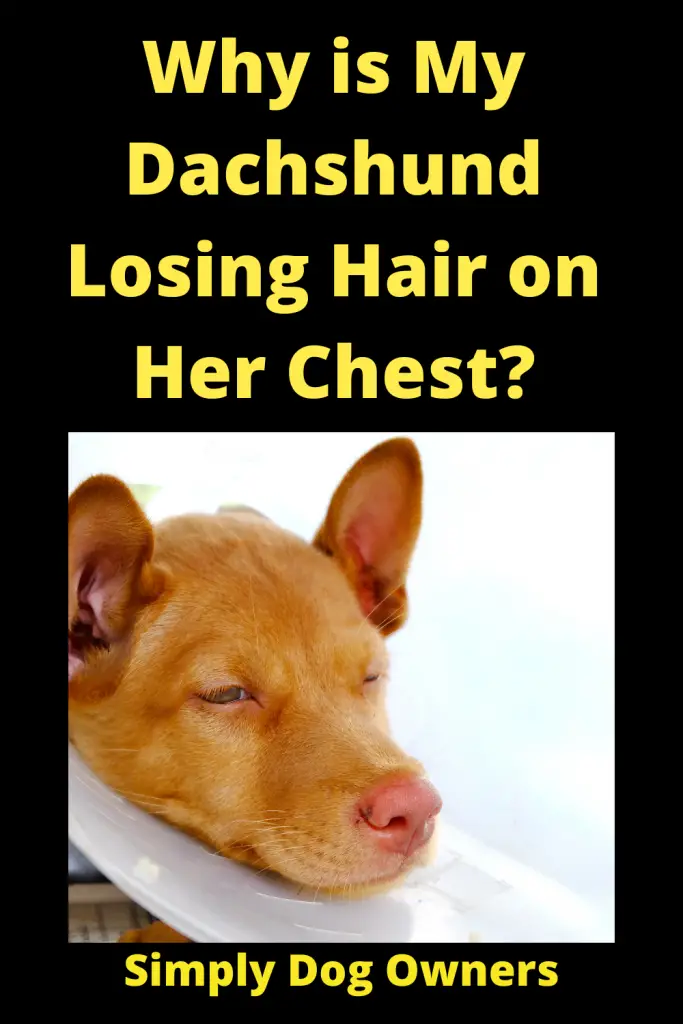
What Health Problems cause Hair Loss in Dachshunds?
These are the following factors that cause hair loss in Dachshunds
1. Alopecia
As discussed above (Most common cause)
2. Acanthosis Nigricans
A rare reason for hair loss in dachshunds is a condition called Acanthosis Nigricans. This condition is most common in Dachshunds and probably appears up before they’re a year old. It can even affect humans companions too. The condition is a hyperpigmentation of the upper skin and shows up in uneven patches with hair loss.
The hair loss patches are darker than the Dachshund’s skin color and are usually found on the chest down to the crotch.
3. Cushing’s Disease
This disease represents an overproduction of cortisol; the hormone dogs produce when they’re stressed. It’s normal to produce it when faced with a stressful situation, but it can be dangerous if it builds up in the blood.
Other symptoms include excessive panting, eating and drinking, and developing a bloated belly. This is because cortisol increases appetite. If the findings are promising, the veterinarian would need to find out what caused the issue before suggesting a treatment plan.
4. Hypothyroidism
Hypothyroidism is a common disorder of the affected thyroid gland. This term applies to an underactive thyroid, as opposed to hyperthyroidism when the thyroid is overactive. The thyroid gland controls hormone output and is located in the neck.
An underactive thyroid produces hormones slowly, particularly those required for a healthy metabolism. Understandably, weight gain is one of hypothyroidism’s side effects. Other beauty problems include scaly or contaminated skin, as well as a dull, patchy coat.
Your dogie will continue to take medicine for the rest of their lives because this is a severe illness. You’ll still need to put them on a special diet. The veterinarian will use blood and urine samples to diagnose this disorder. Check-in with a veterinarian right away if you have any of the signs mentioned above, as well as general lethargy or depression.
5. Allergic reactions
Scratching or pulling off fur causes hair loss in this situation. When a dog has an allergic reaction, its skin becomes irritated, and it may attempt to alleviate it. Allergens can come from a variety of places and influence your dog.
· Food allergens
Not to be forgotten, confident dogs, like humans, are allergic to some forms of food. It might be something you send them daily or something they stole once. The best way to determine whether you have a food allergy is to see a veterinarian who can conduct tests. Consult a doctor if your dog has diarrhea or vomiting after consuming those foods. Excessive licking and ear infections are also signs.
· Bites from Insects
Any insect bite can cause an allergic reaction, resulting in scratching and biting. However, some are more likely than others to cause hair loss. Fleas are considered to be the most common cause of dog hair loss. These bugs bite your dog to feed on their blood, causing itchy eyes. The same effect is caused by a mite infestation, also known as ‘mange.’ If your dog is infested with one of these pests, you’ll see them scratching nonstop. When you get close enough, you’ll find that their skin is constantly inflamed and infected. Fortunately, these problems are simple to define and treat.
· Drug/Medicine allergens
Unfortunately, the very thing that is supposed to help with one problem can end up causing another. Rashes or skin complaints are typical side effects of many drugs. Scratching and hair loss can occur as a result of this. If your dog is on any medications, check the package or consult your veterinarian to see if this is the cause.
If it turns out that the medicine is causing hair loss, the vet will advise you on the best course of action based on the length of the treatment. If your dog is chewing and biting their skin, they will most likely prescribe a cream or a cone as a short-term treatment.
· Trauma
If your furry friend has been through a traumatic event, they may lose their fur as a result. It’s more common in rescue dogs who had a difficult start in life. However, a dog attack, an accident, invasive treatment, or surgery can cause it.
Because our dogs cannot communicate with us and express their distress, their emotions are manifested in their physical health.
How to Prevent Hair Loss in Dachshunds?
Preventing hair loss in your dog helps to avoid skin damage and the creation of undesirable habits like chewing or scratching, as well as enhancing your dog’s overall health. Many conditions cause hair loss to harm your dog’s health in other ways, including organ damage if hormonal or endocrine imbalances are present.
The overall health of the dog is improved by treating the source of hair loss. Furthermore, you’ll want to address parasites and fungal infections that could affect other pets in the house, as well as you and your family members, until they become a problem that spreads in your home. Hair loss in cold weather can cause frostbite, and precautions must be taken to protect dogs experiencing hair loss if exposed to severely cold temperatures, which can be uncomfortable, complex, or expensive.
If hair loss occurs and the underlying causes are not addressed, skin damage, such as scarring, may prevent hair regrowth, resulting in a permanent condition.
What Vitamin Deficiencies cause hair loss in Dachshunds?
Vitamins deficiencies that can cause hair loss, according to researchers, include:
- Vitamin D deficiency may cause hair to thin or stop developing.
- Zinc deficiency can cause hair loss similar to iron deficiency and damage and breakage of any remaining hair.
- Selenium: According to Armani, selenium deficiency is unusual. When this happens, it may cause hypothyroidism and hair loss by disrupting thyroid function.
- Another common cause of hair loss in dogs is iron deficiency, suggesting an underlying medical condition. Iron aids in the development of hemoglobin, which aids in delivering nutrients and oxygen to hair follicles. Hair won’t expand if there isn’t enough iron, resulting in increasingly thinner hair. The following are several other possible causes of iron deficiency:
Vitamin-related hair loss in dogs can cause more than just hair loss on their heads. The shedding of eyebrows and lashes can also be caused by damage to hair follicles.
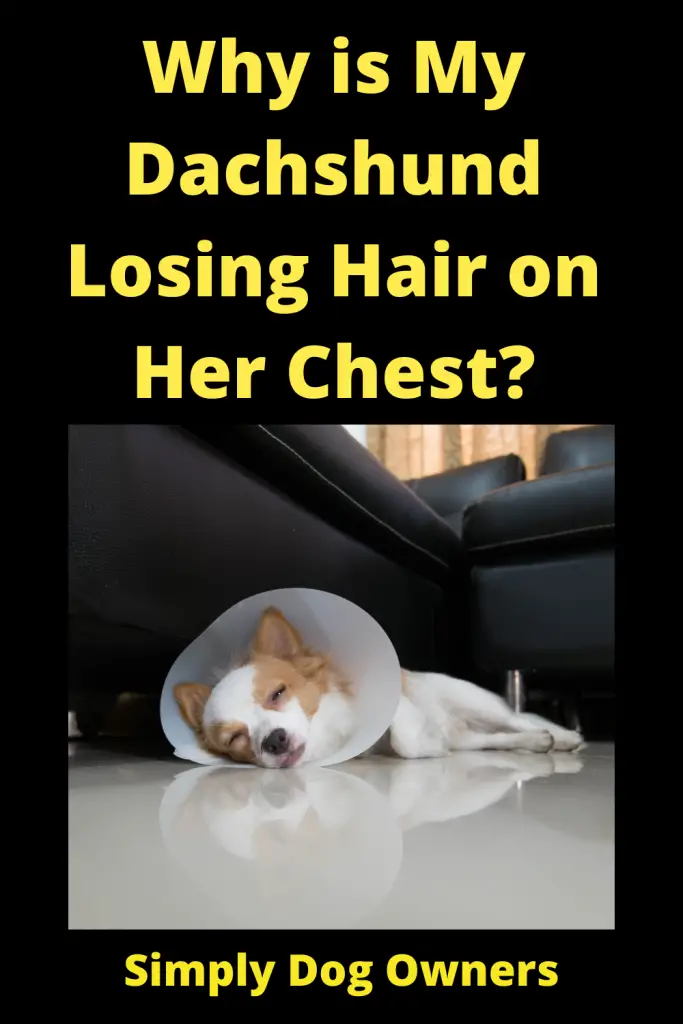
Dog Hair Loss Home Remedies
Here are some of the best and easiest homemade remedies to prevent hair loss in dogs.
1. Provide a More Natural Diet For Your Dog
The health of your dog’s haircoat is determined by the food he consumes. First and foremost, switch out the store-bought name-brand dog food for a more natural brand. Introduce your dog to some homemade treats. You might, for example, give your dog some cooked chicken breast. You may also offer the dog fully cooked vegetables or fully cooked rice. You can negotiate homemade pet diets with your veterinarian to ensure a well-balanced homemade pet diet.
2. Have Lemon Juice for your canine
Because of the citric acid in lemon juice, most people are aware that it has antibacterial properties. If there is a minor bacterial overgrowth present, this juice can effectively treat hair loss. For around five hours, infuse a quart of warm water with a slice of lemon. To remove any pulp or debris from the liquid, strain it afterward. To treat your furry friend’s hair loss, add the infusion to the affected areas.
3. Flaxseed Oil is a good option.
It would help if you also considered incorporating flaxseed oil or flaxseeds into your dog’s diet. Flaxseed oil has a high concentration of Omega 3 fatty acids. Omega 3 fatty acids present in flaxseed have been found to help dogs with dry, itchy skin and hair coats.
Omega 3 fatty acids also aid in treating inflammation in the joints, heart, and skin. This is why it is effective in treating hair loss in dogs.
4. Massage Olive Oil Into Your Pet’s Fur
Your dog would love olive oil. Try rubbing some olive oil in the palm of your hand if your pet is losing fur. Gently massage your pet. The olive oil will also help your dog have a shinier coat, and they will enjoy your massage.
5. Aloe Vera Hair Loss Treatment
Aloe Vera can also help with hair loss. If your dog’s scratching is causing hair loss, add Aloe Vera to his skin to relieve itching.
Aloe Vera provides a variety of nutrients and enzymes that are helpful to a dog’s hair and skin. These enzymes may help remove dead skin cells, obstructing the uptake of nutrients that healthy hair needs.
Final Thoughts
Hair loss in Dachshunds is often associated with itchy skin, which may lead to lesions or infections. Fortunately, many causes of hair loss are reversible and treatable. But it’s best not to dismiss the reality that it’s taking place. Even though it is easy to treat with creams, hair loss could be a sign of a more severe health problem that, if left untreated, could be dangerous.
